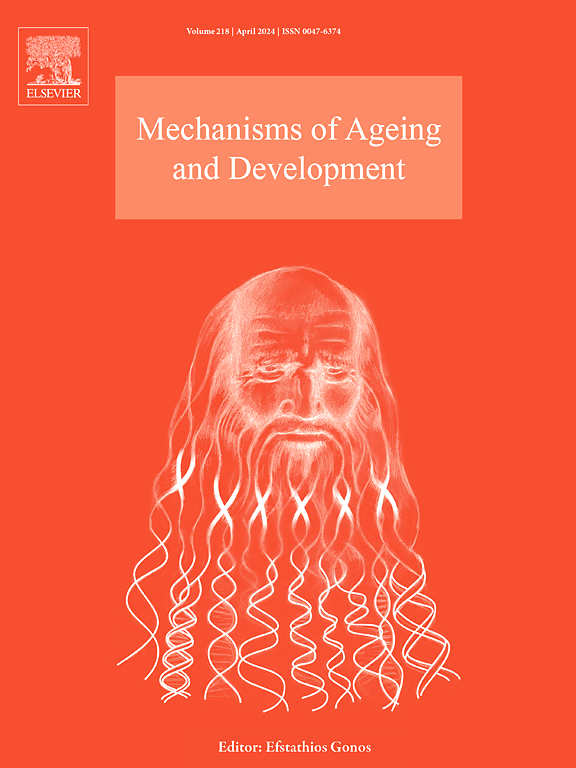Transcriptomic and epigenomic signatures of liver metabolism and insulin sensitivity in aging mice
IF 5.1
3区 医学
Q2 CELL BIOLOGY
引用次数: 0
Abstract
Age-related declines in insulin sensitivity and glucose metabolism contribute to metabolic disease. Despite the liver’s central role in glucose homeostasis, a comprehensive phenotypic characterization and concurrent molecular analysis of insulin resistance and metabolic dysfunction in the aging liver is lacking. We characterized hepatic insulin resistance and mitochondrial metabolic defects through metabolic cage, hyperinsulinemic-euglycemic clamp, and tracer studies paired with transcriptomic and DNA methylation analyses in young and aged male mice. Aged mice exhibited benchmark measures of whole body and liver insulin resistance. Aged mice showed lower pyruvate dehydrogenase flux, decreased fatty acid oxidation and citrate synthase fluxes, and increased pyruvate carboxylase flux under insulin-stimulated conditions. Molecular analysis revealed age-related changes in metabolic genes Pck1, Socs3, Tbc1d4, and Enpp1. Unsupervised network analysis identified an intercorrelated phenotype module (ME-Glucose), RNA module, and DNA methylation module. The DNA methylation module was enriched for lipid metabolism pathways and TCF-1 binding, while the RNA module was enriched for MZF-1 binding and regulation by miR-155–5p. Protein-protein interaction network analysis revealed interactions between module genes and canonical metabolic pathways, highlighting genes including Ets1, Ppp1r3b, and Enpp3. This study reveals novel genes underlying age-related hepatic insulin resistance as potential targets for metabolic interventions to promote healthy aging.
衰老小鼠肝脏代谢和胰岛素敏感性的转录组学和表观基因组特征
与年龄相关的胰岛素敏感性和葡萄糖代谢下降会导致代谢性疾病。尽管肝脏在葡萄糖稳态中起着核心作用,但目前缺乏对衰老肝脏中胰岛素抵抗和代谢功能障碍的综合表型表征和同步分子分析。我们通过代谢笼、高胰岛素-正糖钳和示踪剂研究,结合转录组学和DNA甲基化分析,对年轻和老年雄性小鼠进行了肝脏胰岛素抵抗和线粒体代谢缺陷的研究。老年小鼠表现出全身和肝脏胰岛素抵抗的基准指标。在胰岛素刺激条件下,老年小鼠丙酮酸脱氢酶通量降低,脂肪酸氧化和柠檬酸合成酶通量降低,丙酮酸羧化酶通量增加。分子分析显示代谢基因Pck1、Socs3、Tbc1d4和Enpp1的年龄相关变化。无监督网络分析确定了相互关联的表型模块(ME-Glucose)、RNA模块和DNA甲基化模块。DNA甲基化模块富集用于脂质代谢途径和TCF-1结合,而RNA模块富集用于MZF-1结合和miR-155-5p调控。蛋白质-蛋白质相互作用网络分析揭示了模块基因与典型代谢途径之间的相互作用,突出显示了包括Ets1, Ppp1r3b和Enpp3在内的基因。这项研究揭示了与年龄相关的肝脏胰岛素抵抗的新基因,作为代谢干预促进健康衰老的潜在靶点。
本文章由计算机程序翻译,如有差异,请以英文原文为准。
求助全文
约1分钟内获得全文
求助全文
来源期刊
CiteScore
11.10
自引率
1.90%
发文量
79
审稿时长
32 days
期刊介绍:
Mechanisms of Ageing and Development is a multidisciplinary journal aimed at revealing the molecular, biochemical and biological mechanisms that underlie the processes of aging and development in various species as well as of age-associated diseases. Emphasis is placed on investigations that delineate the contribution of macromolecular damage and cytotoxicity, genetic programs, epigenetics and genetic instability, mitochondrial function, alterations of metabolism and innovative anti-aging approaches. For all of the mentioned studies it is necessary to address the underlying mechanisms.
Mechanisms of Ageing and Development publishes original research, review and mini-review articles. The journal also publishes Special Issues that focus on emerging research areas. Special issues may include all types of articles following peered review. Proposals should be sent directly to the Editor-in-Chief.

 求助内容:
求助内容: 应助结果提醒方式:
应助结果提醒方式:


